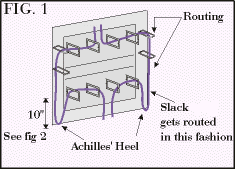| How a patch cord is routed - the key to designing a management system. |
|
When designing a patch-cord management system, what often happens is the overlooking of an obvious point . The simple task of determining how patch cords will be installed prior to the implementation of the management system must be analized so that a designer can implement the right management for the job. |
 |
|
How patch cord
should be routed. Although routing a patch cord to eliminate or minimize slack seems like a simple concept, it does not work. For this method to work and to minimize the slack of the cord it would require the end user to possibly figure out a new route each time a cord is patched. It's like reading a map. You would have to look at the wire manager's routes, and the patch- cord length, see that if you were to route it through this horizontal manager, then take it down these vertical managers, to see that you would end up with very little slack when the patch is completed, or to see if another route would be better. See what I mean! How a patch cord
is really routed. |
|||||||||||
| Designing
with the Achilles' Heel in mind. As a designer of the management system you can see that the example I gave you, although it may vary with different management layouts, will produce the same results. The slack of the cords will have to be managed in only one part of the management system after the patch is complete (when a patch-cord adjusters are not installed). This is where your concentrated efforts will be: eliminating or minimizing the slack at your management system Achilles' heel. |
|||||||||||
|